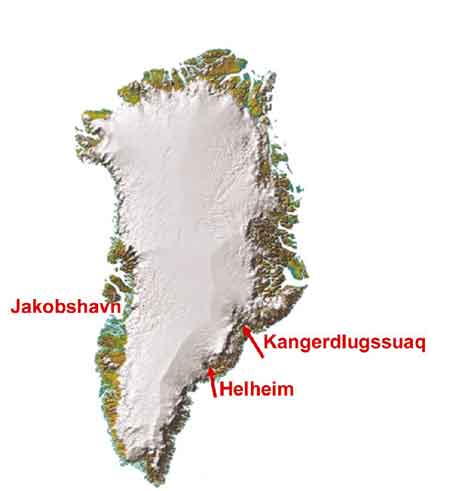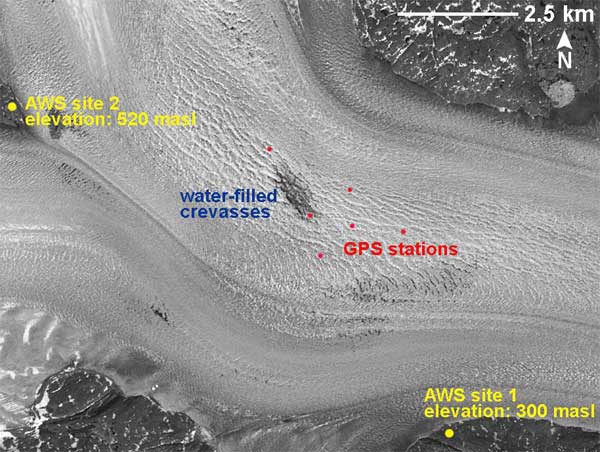Leigh Stearns
Introduction
Mass from the interior of the Greenland ice sheet is transported to the ocean by numerous large, fastflowing outlet glaciers. Changes in the flow configuration of these outlet glaciers modulate ice sheet mass balance and sea level. Recent estimates show that Greenland's contribution to sea level has more than doubled in the past decade, increasing from 0.23 ▒ 0.08 mm/yr in 1996, to 0.57 ▒ mm/yr in 2005, and that the majority of this mass loss is due to changes in the flow configuration of a few large outlet glaciers (Rignot and Kanagaratnam, 2006). Three glaciers in particular (Kangerdlugssuaq Glacier, Helheim Glacier, and Jakobshavn IsbrŠ), have undergone dramatic acceleration, retreat and thinning in the past 5 years (Stearns and Hamilton, 2005).

Figure 1: Location of the fast moving outlet glaciers discussed in this proposal.
Between 2001 and 2005, Kangerdlugssuaq Glacier, Helheim Glacier, and Jakobshavn IsbrŠ (Figure 1) each accelerated 30-300%, retreated >5 km, and thinned >100 meters. There is compelling evidence that these sudden changes were triggered by warm summer temperatures. On Kangerdlugssuaq and Helheim glaciers, the initial acceleration coincided with an especially warm summer and a modeled increase in melting degree days (based on measurements from the nearest available weather station). The warmer summer temperatures cause an increase in melt ponds on the glacier surface. We hypothesize that enhanced lubrication caused by an increase in surface meltwater reaching the bed caused flow acceleration. In support of this hypothesis, flow velocities derived from repeat satellite imagery show velocity "bullseyes" located directly down-flow of large melt ponds. Acceleration from surface melt percolating to the bed and causing lubrication has been observed on the inland ice sheet in west Greenland (the so-called 'Zwally effect') (Zwally et al., 2002).
Research Objectives
The Arctic plays a prominent role in global climate change research because of both its sensitivity to changing climate and because of the relative wealth of paleoenvironmental proxy records available. Proxy records developed through physical and chemical analyses of ice cores provide the highest resolution and most direct view of Earth's paleoatmosphere over time scales ranging from single seasons to hundreds of thousands of years. Recent research efforts have focused on developing high resolution ice core records from the St. Elias Mountains in southwestern Yukon Territory and southeastern Alaska (Fig 1). During the summers of 2001 and 2002, scientists from the Geological Survey of Canada (GSC), National Institute for Polar Research in Tokyo, University of New Hampshire (UNH), and University of Maine (UMaine) recovered ice cores from three different glaciers in the St. Elias Mountains, southwestern Yukon Territory. On the Eclipse Icefield (~30 km northeast of the Logan Massif) an UNH/UMaine team recovered a 345 m core along with three other shallower cores.
- How sensitive is ice velocity to fluctuations in melt pond volume?
- How do melt ponds and water filled crevasses evolve throughout the season? How does their volume fluctuate throughout the summer months?
- How does ice velocity change through an entire summer season? Does it increase throughout the season or does it remain relatively constant? Is the ice moving steadily, or is the motion taken up in several short bursts of movement?
- What is the local air temperature and weather characteristics at different elevations along the glacier (current degree day models rely on weather observations 80 km, and 1000 vertical meters away)?
There are three components to our proposed field program: determine ice velocity variations with global positioning system (GPS) measurements; monitor melt water production by placing a pressure transducer in a large melt pond; and record the local weather with at least one automatic weather station (AWS). We plan on deploying all the equipment on the glacier for the entire summer season (June - September, 2006), with data being recorded (on average) every minute.

Figure 2. Proposed setup of field equipment. Five GPS stations will be deployed down-stream of a large melt pond. If time permits, we will place a sixth GPS unit up-stream of the melt pond, as a control. An automatic weather station (AWS site) will be installed on an adjacent mountain ridge. Given any flexibility in the logistics, we will position two AWS sites at two different elevations, to quantify the effect of elevation on weather observations (lapse rate).
Our project evolved as a partnership with colleagues from Harvard University, Lamont-Doherty Earth Observatory (LDEO), the Danish National Space Center (DNSC), the Geological Survey of Denmark and Greenland (GEUS), and the Consejo Superior de Investigaciones Cientificas, Spain (CSIC). The objective of the larger project is to characterize the behavior of glacial earthquakes beneath fast moving outlet glaciers in Greenland (Ekstr÷m et al., 2006). The seasonality and distribution of these earthquakes implies a correlation with subglacial hydrology. We hypothesize that the subglacial drainage system, which must adjust for an increases in melt water due to warming, causes glacier acceleration and small seismic events.
Fieldwork Details and Logistics
I am requesting support from the Churchill Foundation for 14-days of lodging at Hotel Angmagssalik ($70/day). The hotel is located in the southeast Greenland town of Tasiilaq, roughly 80 km from our field site. The remaining cost of the project will be covered by Dr. Hamilton and our project partners. Funds requested here will support my involvement in investigating meltpond evolution and ice velocity (a project which was not planned otherwise).
References
Ekström, G. et al. 2006. Seasonality and increasing frequency of Greenland glacial earthquakes, Science, 311.
Rignot, E. and P. Kanagaratnam. 2006. Changes in the velocity structure of the Greenland Ice Sheet, Science, 311.
Stearns, L.A. and G.S. Hamilton. 2005. Rapid changes of large tidewater glaciers in SE Greenland, AGU meeting. Zwally, H.J. et al. 2002. Surface melt induced acceleration of Greenland Ice Sheet flow. Science, 297.
